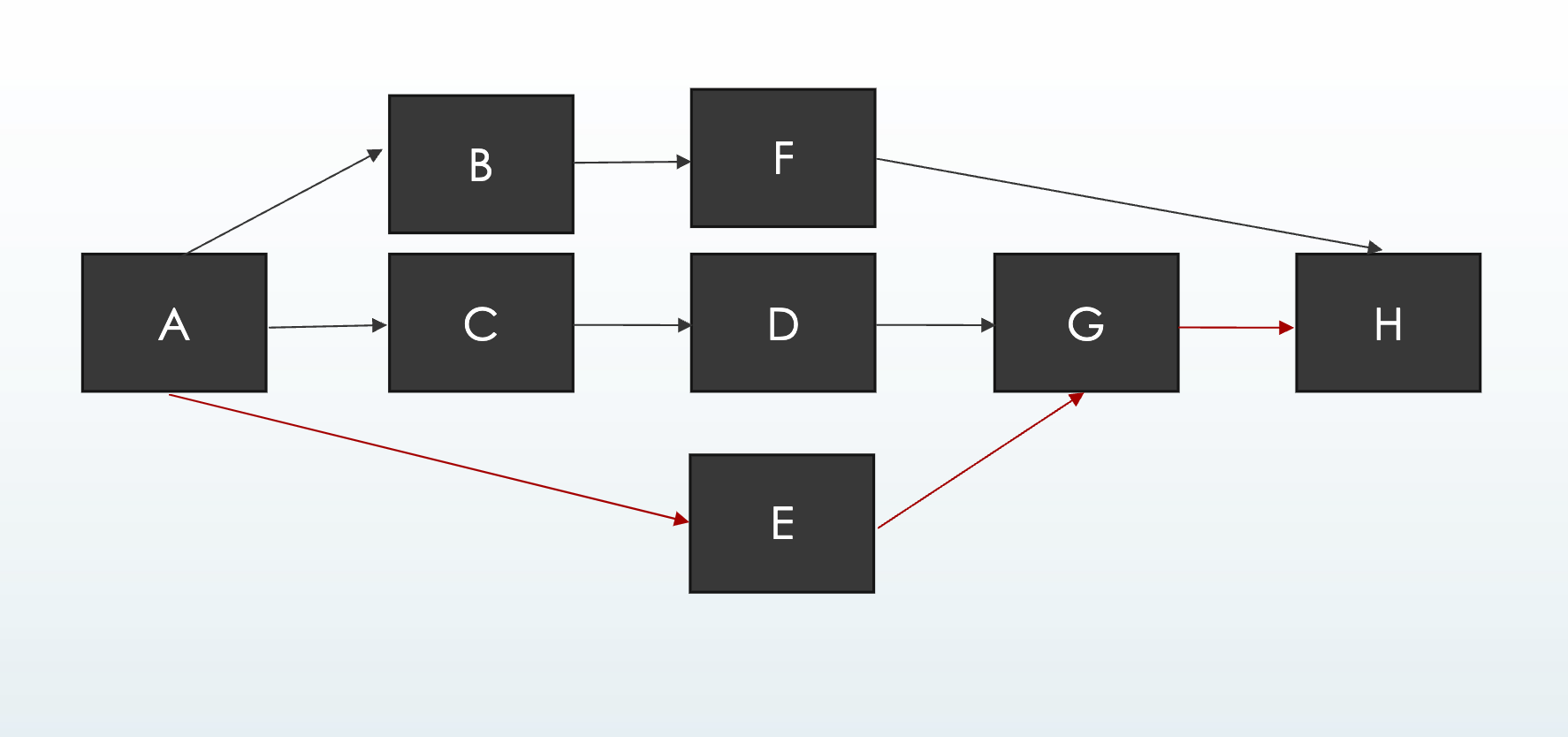Curriculum
Project Management Professional in (PMP) - praktyczne wskazówki
Zarządzanie Projektami Podstawy
0/17Obszary wiedzy i procesy
0/5Integration management
0/24Scope management
0/11Schedule Management
0/18-
Zarządzanie harmonogramem projektu - Schedule management
-
Definiowanie działań
-
Sekwencje
-
Network diagram
-
Szacowanie
-
Szacowanie część 2
-
Szacowanie część 3
-
Podsumowanie Schedule management
-
Kroki w schedule management
-
Wykres Gantta
-
Fast tracking i crashing
-
Leveling and Smoothing
-
Proces Kontroli Harmonogramu
-
Agile
-
Critical Path Method
-
Monte Carlo
-
Obliczanie Critical Path
-
Rolling Wave Planning
Cost management
0/5Quality Management
0/5Resource management
0/14Zarządzanie Komunikacją
0/7Zarządzanie ryzykiem
0/14Procurement management
0/8Interesariusze
0/5Agile
0/22Critical Path Method

Zacznijmy od wyjaśnienia, czym jest ścieżka krytyczna.
W diagramie sieciowym może istnieć kilka ścieżek, które zaczynają się na początku projektu i kończą na jego zakończeniu. Przykładowo, w tym diagramie sieciowym mamy trzy możliwe ścieżki:
- A, B, F, H
- A, C, D, G, H
- A, E, G, H
Jedna lub więcej z tych ścieżek może być krytyczna. Opóźnienie w działaniach na tych ścieżkach powoduje takie samo opóźnienie w całkowitym czasie trwania projektu.
Na przykład, jeśli w naszym diagramie sieciowym ścieżka A, E, G, H jest ścieżką krytyczną, każde opóźnienie w działaniach A, E, G lub H spowoduje opóźnienie całego projektu. Dlatego te działania są niezwykle istotne i musimy je monitorować, aby uniknąć opóźnień projektu. Dlatego też ta ścieżka nazywana jest ścieżką krytyczną.
Działania, które nie znajdują się na ścieżce krytycznej, mogą być opóźnione bez wpływu na inne działania lub całkowity czas trwania projektu. W naszym diagramie sieciowym działania A, B, C, D i F nie znajdują się na ścieżce krytycznej i dlatego mają pewną tolerancję na opóźnienia, nazywaną zapasem (float lub slack). Oba terminy oznaczają to samo i mogą pojawić się na egzaminie.
Jedną z najważniejszych rzeczy, które musisz wiedzieć o metodzie ścieżki krytycznej, jest to, że ponieważ ścieżka krytyczna nie ma tolerancji na opóźnienia, jej zapas wynosi zero. To kluczowa informacja: ponieważ ścieżka krytyczna nie ma tolerancji na opóźnienia, jej zapas wynosi zero. Oznacza to również, że zapas wszystkich działań na ścieżce krytycznej wynosi zero.
Teraz omówmy rodzaje zapasu:
- Zapas całkowity (Total Float): Tolerancja opóźnienia działania bez wpływu na całkowity czas trwania projektu. Każde opóźnienie w granicach zapasu całkowitego nie wpłynie na całkowity czas trwania projektu.
- Zapas wolny (Free Float): Tolerancja opóźnienia działania bez wpływu na wczesną datę rozpoczęcia działań następczych. Opóźnienie w granicach zapasu wolnego nie wpłynie na wczesną datę rozpoczęcia kolejnego działania.
- Zapas projektu (Project Float): Tolerancja opóźnienia działania bez wpływu na ustalony czas trwania projektu. Ten czas może być określony przez sponsora, klienta lub kierownika projektu. Opóźnienie w granicach zapasu projektu nie zmieni ustalonego terminu zakończenia projektu.
Teraz jesteśmy gotowi, aby omówić metodę ścieżki krytycznej. Ta metoda pomaga określić krytyczne ścieżki w diagramie sieciowym i obliczyć zapas dla każdego działania.
In this lecture, we will learn how to perform scheduling calculations using the Critical Path Method (CPM).
First, let’s talk about the critical path.
In a network diagram, there may be several paths that start from the beginning and finish at the end. For example, in this network diagram, there are three possible paths:
- A, B, F, H
- A, C, D, G, H
- A, E, G, H
Among these paths, one or more can be critical. Any delay in these paths causes the same amount of delay in the total project duration.
For example, let’s say in our network diagram, A, E, G, H is the critical path. Any delay in activities A, E, G, or H will cause the same delay in the overall project duration. Therefore, these activities are extremely critical, and we need to monitor them closely to avoid project delays. This is why this path is called the critical path.
Activities that are not on the critical path can be delayed without affecting other activities or the overall project duration. In our network diagram, activities A, B, C, D, and F are not on the critical path and therefore have some delay tolerance. This delay tolerance is called float or slack. Both terms mean the same, and you might encounter either term in the exam.
One of the most important things to know about the Critical Path Method is that since the critical path has no delay tolerance, its float equals zero. This is crucial, so let’s repeat it: since the critical path has no delay tolerance, its float equals zero. This also means that the float of all activities on the critical path is zero.
Now, let’s talk about the types of float:
- Total Float: An activity’s delay tolerance without affecting the total project duration. Any delay up to the total float amount will not affect the project’s total duration.
- Free Float: An activity’s delay tolerance without affecting the early start date of successor activities. Any delay up to the free float amount will not affect the early start date of the successor activity or activities.
- Project Float: An activity’s delay tolerance without affecting the target project duration. This target duration may be given by the sponsor, customer, or project manager. Any delay up to the project float will not change this target duration.
Now we are ready to talk about the Critical Path Method. This method determines the critical path or paths of a network diagram and calculates the float for each activity.